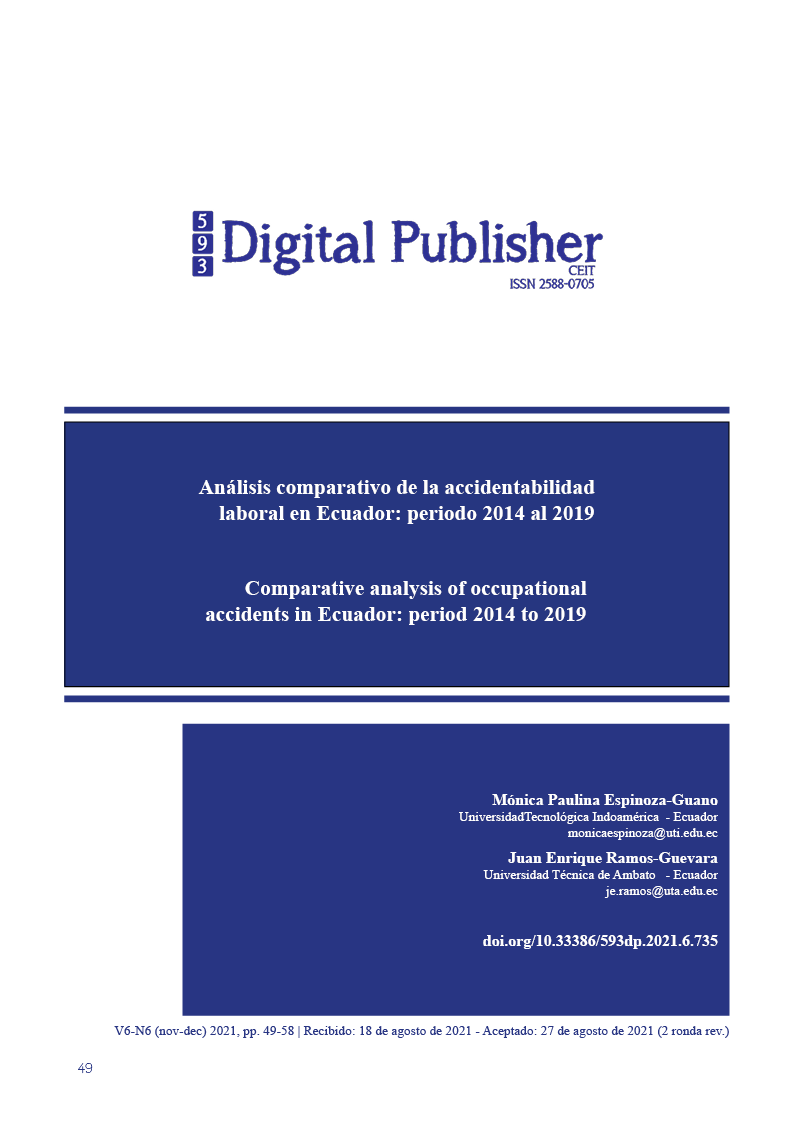Comparative analysis of occupational accidents in Ecuador: period 2014 to 2019
Main Article Content
Abstract
Occupational accident rates in Ecuador are highly important both due to the social, economic and academic impact it generates; safety and health at work is essential, however, its application has not resulted in a matter of conscience, unleashing more work accidents at the local, regional, national and global level; Therefore, the objective of this study is to analyze the workplace accident rate in Ecuador from a comparative perspective from 2014 to 2019, taking as a basis the accident rate statistics registered in the Ecuadorian Institute of Social Security, the variables analyzed were: number of occupational accidents- Qualified injuries, accidents classified by economic sector, gender and type of disability. As a conclusion, it was obtained that the number of qualified work accidents shows a decrease especially between 2016 and 2017 in manufacturing and construction companies, sectors in which the highest number of accident notices are registered. The disabilities generated by the accidents were temporary, partial and total, the same ones that are mostly associated with the male gender. In addition, it was found that sectors such as services and commerce present an increase in the number of accidents, which is why it is important to socialize regulations and training programs in these economic sectors, taking into account that they present a growing evolution Regarding the number of companies, it is imperative to raise awareness of occupational safety in order to minimize the professional damages that, when materialized, negatively impact the profitability and organizational image.
Downloads
Article Details

This work is licensed under a Creative Commons Attribution-NonCommercial-ShareAlike 4.0 International License.
1. Derechos de autor
Las obras que se publican en 593 Digital Publisher CEIT están sujetas a los siguientes términos:
1.1. 593 Digital Publisher CEIT, conserva los derechos patrimoniales (copyright) de las obras publicadas, favorece y permite la reutilización de las mismas bajo la licencia Licencia Creative Commons 4.0 de Reconocimiento-NoComercial-CompartirIgual 4.0, por lo cual se pueden copiar, usar, difundir, transmitir y exponer públicamente, siempre que:
1.1.a. Se cite la autoría y fuente original de su publicación (revista, editorial, URL).
1.1.b. No se usen para fines comerciales u onerosos.
1.1.c. Se mencione la existencia y especificaciones de esta licencia de uso.
References
Aneziris, O. N., Papazoglou, I. A., & Kallianiotis, D. (2010). Occupational risk of tunneling construction. Safety Science, 48(8), 964–972. https://doi.org/10.1016/j.ssci.2009.11.003
Barley, S. R., Meyerson, D. E., & Grodal, S. (2011). E-mail as a source and symbol of stress. Organization Science, 22(4), 887–906. https://doi.org/10.1287/orsc.1100.0573
Carpintero Pérez, Paula; Lago Antón, Safira; Neyra Castañeda, Alejandra; Terol Conthe, Inés. (2014). ¿Es coste-efectivo el desarrollo de programas de promoción de la salud en los lugares de trabajo?. Journal Medicina y Seguridad del Trabajo. Volumen 60. Issue 236. Número de Páginas 566-586. ISSN 0465-546X
Directorio de Empresas del Instituto Nacional de Estadísticas y Censos. Obtenido de https://public.tableau.com/app/profile/instituto.nacional.de.estad.stica.y.censos.inec./viz/VisualizadordeEstadisticasEmpresariales/Dportada
Duque, D. (2017). Modelo teórico para un sistema integrado de gestión (seguridad, calidad y ambiente). Ingeniería Industrial. Actualidad y Nuevas Tendencias, (18), 115-130
Español, E. P. (2001). La conducta humana frente a los riesgos laborales: determinantes individuales y grupales. Acciones e investigaciones sociales, (12), 157-184.
Estadísticas del Seguro de Riesgos del Trabajo. Obtenido de https://app.powerbi.com/view?r=eyJrIjoiY2ZlMzAzZDItNGQ3OS00NmVlLWJkYjktNzU0MmZjY2FlMTg5IiwidCI6IjZhNmNlOGVkLTBlMGYtNDY4YS05Yzg1LWU3Y2U0ZjIxZjRmMiJ9
Filer RK, Golbe DL. Debt, operating margin, and investment in workplace safety. The Journal of Industrial Economics. 2003; 51(3): 359-81.
Järvholm B, Albin M, Johansson G, Wadensjö E. Perspectives of working life research. Scand J Work Environ Health. 2009; 35 (5): 394-6.
Medina Freire, E. R. (2016). Diagnóstico de seguridad y salud ocupacional en Ecuador. Obtenido de http://repositorio.uisek.edu.ec/handle/123456789/2061
Mendoza, C. A. A. (2017). Implantación de un sistema de gestión de seguridad y salud en el trabajo basado en el modelo Ecuador. Dominio de las ciencias, 3(4), 264-283.
Mohandes, S. R., Sadeghi, H., Mahdiyar, A., Durdyev, S., Banaitis, A., Yahya, K., & Ismail, S. (2020). Assessing construction labours’ safety level: A fuzzy MCDM approach. Journal of Civil Engineering and Management, 26(2), 175–188. https://doi.org/10.3846/jcem.2020.11926
Organización Internacional de Trabajo OIT (2020) https://www.ilo.org/global/topics/safety-and-health-at-work/lang--es/index.htm
Riano, M., Palencia, F. (2016). Dimensión económica de la seguridad y la salud en el trabajo: una revisión de literatura. Revista Gerencia y Políticas de Salud. Volumen 15. Issue 30. Número de Páginas 24-37.DOI https://doi.org/10.11144/Javeriana.rgyps15- 30.dess. ISSN 1657-7027.
Sarkar, S., Vinay, S., Raj, R., Maiti, J., & Mitra, P. (2019). Application of optimized machine learning techniques for prediction of occupational accidents. Computers and Operations Research, 106, 210–224. https://doi.org/10.1016/j.cor.2018.02.021
Van Dongen, JM, Tompa, E., Clune, L. et al. Cerrar la brecha entre la literatura de evaluación económica y la práctica diaria en salud ocupacional: un estudio cualitativo entre los tomadores de decisiones en el sector de la salud. Implementación Sci 8, 57 (2013). https://doi.org/10.1186/1748-5908-8-57
Vaquero-Diego, M., Torrijos-Fincias, P., & Rodriguez-Conde, M. J. (2020). Relation between perceived emotional intelligence and social factors in the educational context of Brazilian adolescents. Psicologia: Reflexao e Critica, 33(1), 1–10. https://doi.org/10.1186/s41155-019-0139-y
Weissberg, R. P., Goleman, D., Cherniss, C., & Extein, M. (2006). Emotional Intelligence: What Does the Research Really Indicate? Educational Psychologist, 41(4), 239–245.
Yturralde Villagómez, J. G. (2020). Accidentabilidad laboral en las empresas públicas y privadas en Ecuador en el período 2014-2015.
Zhang W-R, Wang K, Yin L, Zhao W-F, Xue Q, Peng M, et al. Mental Health and Psychosocial Problems of Medical Health Workers during the COVID-19 Epidemic in China. Psychother Psychosom (2020). 89, 242–250 https://doi.org/10.1159/000507639



